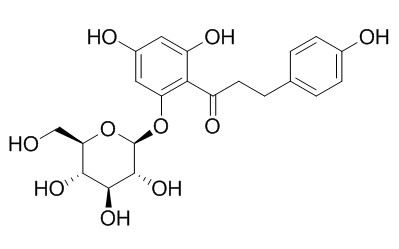Phlorizin
Phlorizin is a non-selective SGLT inhibitor with Kis of 300 and 39 nM for hSGLT1 and hSGLT2, respectively. Phlorizin is also a Na+/K+-ATPase inhibitor. Phlorizin may be a novel therapeutic approach for the treatment of diabetic nephrolog, it protects mice from diabetic nephrology. Phlorizin prevents ventricular tachyarrhythmia through the improvement of impulse conduction slowing during ischemia.
Inquire / Order:
manager@chemfaces.com
Technical Inquiries:
service@chemfaces.com
Tel:
+86-27-84237783
Fax:
+86-27-84254680
Address:
1 Building, No. 83, CheCheng Rd., Wuhan Economic and Technological Development Zone, Wuhan, Hubei 430056, PRC
Providing storage is as stated on the product vial and the vial is kept tightly sealed, the product can be stored for up to
24 months(2-8C).
Wherever possible, you should prepare and use solutions on the same day. However, if you need to make up stock solutions in advance, we recommend that you store the solution as aliquots in tightly sealed vials at -20C. Generally, these will be useable for up to two weeks. Before use, and prior to opening the vial we recommend that you allow your product to equilibrate to room temperature for at least 1 hour.
Need more advice on solubility, usage and handling? Please email to: service@chemfaces.com
The packaging of the product may have turned upside down during transportation, resulting in the natural compounds adhering to the neck or cap of the vial. take the vial out of its packaging and gently shake to let the compounds fall to the bottom of the vial. for liquid products, centrifuge at 200-500 RPM to gather the liquid at the bottom of the vial. try to avoid loss or contamination during handling.
Front Plant Sci.2022, 13:982771.
Nat Plants.2016, 3:16205
Molecules.2020, 25(21):5087.
Int J Mol Sci.2019, 20(11):E2734
Gene.2022, 815:146178.
Nat Prod Sci.2018, 24(3):206
bioRxiv - Biochemistry2023, 548213.
Nanjing University of Chinese Medicine2022, 345930.
Front Nutr.2023, 10:1181135.
LWT2020, 124:109163
Related and Featured Products
Am J Physiol Renal Physiol. 2014 Jun 15;306(12):F1520-33.
Competitive inhibition of SGLT2 by tofogliflozin or phlorizin induces urinary glucose excretion through extending splay in cynomolgus monkeys.[Pubmed:
24761001]
Sodium-glucose cotransporter 2 (SGLT2) inhibitors showed a glucose lowering effect in type 2 diabetes patients through inducing renal glucose excretion. Detailed analysis of the mechanism of the glucosuric effect of SGLT2 inhibition, however, has been hampered by limitations of clinical study.
METHODS AND RESULTS:
Here, we investigated the mechanism of urinary glucose excretion using nonhuman primates with SGLT inhibitors tofogliflozin and Phlorizin, both in vitro and in vivo. In cells overexpressing cynomolgus monkey SGLT2 (cSGLT2), both tofogliflozin and Phlorizin competitively inhibited uptake of the substrate (α-methyl-d-glucopyranoside; AMG). Tofogliflozin was found to be a selective cSGLT2 inhibitor, inhibiting cSGLT2 more strongly than did Phlorizin, with selectivity toward cSGLT2 1,000 times that toward cSGLT1; Phlorizin was found to be a nonselective cSGLT1/2 inhibitor. In a glucose titration study in cynomolgus monkeys under conditions of controlled plasma drug concentration, both tofogliflozin and Phlorizin increased fractional excretion of glucose (FEG) by up to 50% under hyperglycemic conditions. By fitting the titration curve using a newly introduced method that avoids variability in estimating the threshold of renal glucose excretion, we found that tofogliflozin and Phlorizin lowered the threshold and extended the splay in a dose-dependent manner without significantly affecting the tubular transport maximum for glucose (TmG).
CONCLUSIONS:
Our results demonstrate the contribution of SGLT2 to renal glucose reabsorption (RGR) in cynomolgus monkeys and demonstrate that competitive inhibition of cSGLT2 exerts a glucosuric effect by mainly extending splay and lowering threshold without affecting TmG.
J Diabetes Complications. 2014 Sep-Oct;28(5):596-603.
Beneficial effects of phlorizin on diabetic nephropathy in diabetic db/db mice.[Pubmed:
24927646]
This study observes the effects of Phlorizin on diabetic nephrology in db/db diabetic mice and explores possible underlying mechanisms.
METHODS AND RESULTS:
Sixteen diabetic db/db mice and eight age-matched db/m mice were divided into three groups: vehicle-treated diabetic group (DM group), diabetic group treated with Phlorizin (DMT group) and normal control group (CC group). Phlorizin was given in normal saline solution by intragastric administration for 10 weeks. Differentially expressed proteins in three groups were identified using iTRAQ quantitative proteomics and the data were further analyzed with ingenuity pathway analysis.
The body weight and serum concentrations of fasting blood glucose (FBG), advanced glycation end products (AGEs), total cholesterol, triglycerides, blood urea nitrogen, creatinine and 24-h urine albumin were increased in the DM group compared to those of the CC group (P<0.05), and they were decreased by treatment with Phlorizin (P<0.05). Morphologic observations showed Phlorizin markedly attenuated renal injury. Phlorizin prevented diabetic nephropathy by regulating the expression of a series of proteins involved in renal and urological disease, molecular transport, free radical scavenging, and lipid metabolism.
CONCLUSIONS:
Phlorizin protects mice from diabetic nephrology and thus may be a novel therapeutic approach for the treatment of diabetic nephrology.
Biol Pharm Bull. 2014;37(7):1168-76.
Phlorizin prevents electrically-induced ventricular tachyarrhythmia during ischemia in langendorff-perfused guinea-pig hearts.[Pubmed:
24989008 ]
Phlorizin is a type of flavonoids and has a peroxynitrite scavenging effect. This study aimed to elucidate the effects of Phlorizin on ischemia-induced ventricular tachyarrhythmia (VT).
METHODS AND RESULTS:
Optical signals from the epicardial surface of the ventricle or left ventricular end diastolic pressure (LVEDP) were recorded during acute global ischemia in 42 Langendorff-perfused guinea pig hearts. Experiments were performed in the control condition and in the presence of Phlorizin or N-2-mercaptopropionylglycine (2-MPG), a peroxynitrite scavenger, respectively. Mean action potential duration at 20 min of ischemia did not differ among the three interventions. Impulse conduction time-dependently slowed during 20 min of ischemia in the control. Phlorizin but not 2-MPG improved the ischemic conduction slowing at 15 and 20 min of ischemia. Programmed stimulation induced VT at 20 min of ischemia in the control and in the presence of 2-MPG but not in the presence of Phlorizin (p<0.05). LVEDP was increased during 30 min of ischemia in the control and in the presence of 2-MPG but not in the presence of Phlorizin.
CONCLUSIONS:
These results indicate that Phlorizin prevents VT through the improvement of impulse conduction slowing during ischemia. Phlorizin may be more useful for ischemia-induced VT than 2-MPG.



